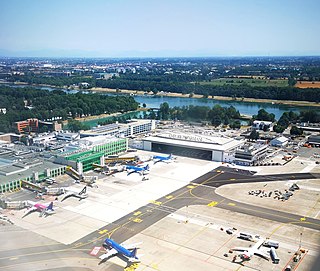
Milan Linate Airport is a city airport located in Milan, the second-largest city and largest urban area of Italy. It served 9,425,962 passengers in 2022 with 101,956 aircraft movements in 2022 making it one of the busiest airports in Italy. It is the third busiest airport in the Milan metropolitan area in terms of passenger numbers, after Malpensa and Bergamo, and the second busiest in terms of aircraft movements.
This is a list of aviation-related events from 1949:
This is a list of aviation-related events from 1953:
This is a list of aviation-related events from 1954:
Air Dolomiti S.p.A. L.A.R.E is an Italian regional airline and a subsidiary of Lufthansa. It is a member of Lufthansa Regional and has its head office in Dossobuono, Villafranca di Verona. Its hubs are at Verona Villafranca Airport, Florence Airport and Venice Marco Polo Airport and focus cities at Munich Airport and Frankfurt Airport in Germany.

The Superga air disaster occurred on 4 May 1949, when a Fiat G.212 of Avio Linee Italiane, carrying the entire Torino football team, crashed into the retaining wall at the back of the Basilica of Superga, which stands on a hill on the outskirts of Turin. All thirty-one people on the flight were killed.

The Fokker F.VII, also known as the Fokker Trimotor, was an airliner produced in the 1920s by the Dutch aircraft manufacturer Fokker, Fokker's American subsidiary Atlantic Aircraft Corporation, and several other companies under license. It was an airliner that could carry 6-12 people, depending on the version, and it used a variety of engines; early versions had one engine but three was more common.

The Savoia-Marchetti S.73 was an Italian three-engine airliner that flew in the 1930s and early 1940s. The aircraft entered service in March 1935 with a production run of 48 aircraft. Four were exported to Belgium for SABENA, while seven others were produced by SABCA. The main customer was the Italian airline Ala Littoria.

Ala Littoria S.A. was the Italian national airline that operated during the fascist regime in the 1930s and 1940s.
Utair is a Russian airline with its head office at Khanty-Mansiysk Airport while its hubs are at Surgut International Airport and Vnukovo International Airport. It operates scheduled domestic and some international passenger services, scheduled helicopter services, and extensive charter flights with fixed-wing aircraft and helicopters in support of the oil and gas industry across western Siberia.

The Fiat G.12 was an Italian transport aircraft of World War II.

The Fiat G.212 was an Italian three-engine airliner of the 1940s. An enlarged development of Fiat's earlier G.12 transport, it was used in small numbers in commercial service and by the Italian Air Force.

The Fiat G.2 was an Italian three-engine six-passenger monoplane transport aircraft designed by Giuseppe Gabrielli and built by Fiat.

Fiat Aviazione was an Italian aircraft manufacturer, at one time part of the Fiat group, focused mainly on military aviation. After World War I, Fiat consolidated several Italian small aircraft manufacturers, like Pomilio and Ansaldo. Most famous were the Fiat biplane fighter aircraft of the 1930s, the Fiat CR.32 and the Fiat CR.42. Other notable designs were the fighters CR.20, G.50, G.55 and a bomber, the Fiat BR.20. In the 1950s, the company designed the G.91 light ground attack plane.

The Fiat G.18 was an Italian airliner developed in the mid-1930s.
Alitalia - Società Aerea Italiana S.p.A., operating as Alitalia, was an Italian airline which was once the flag carrier and largest airline of Italy. The company had its head office in Fiumicino, in the Metropolitan City of Rome Capital. The airline was owned by the Government of Italy as a nationalized business from its founding in 1946 until it was privatized in 2009. However, it struggled with profitability whilst operating as a private company, including failed negotiations to sell to other private parties. The airline entered extraordinary administration in 2017 following many years of financial losses. The Italian government eventually took back ownership of the airline in March 2020.

Arturo Ferrarin was an Italian pioneer aviator. His exploits included winning the "Rome-Tokyo Raid" air race in 1920 and a non-stop flight from Italy to Brazil in 1928 with fellow aviator Carlo Del Prete. The latter flight set the world distance record for a non-stop flight. Ferrarin, who was born in Thiene and was a decorated veteran of the Italian Royal Air Force during World War I, died in a plane crash at Guidonia Montecelio in 1941.

On 1 July 1948 the Avio Linee Italiane Fiat G.212PW “I-ELSA” was an international scheduled passenger flight from Linate Airport, Milan, Italy to Zaventem Airport, Brussels, Belgium. The airplane crashed during an emergency landing at 12:20pm local time. Eight of the twelve people on board were killed.











